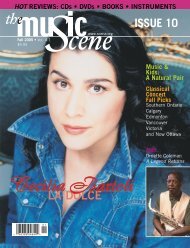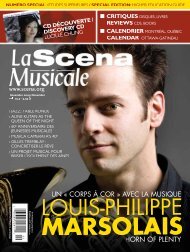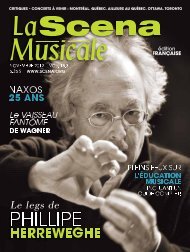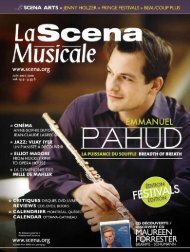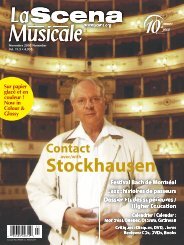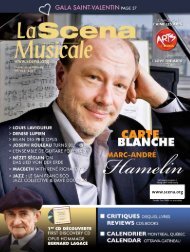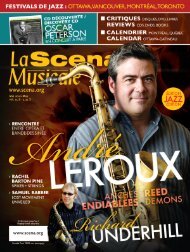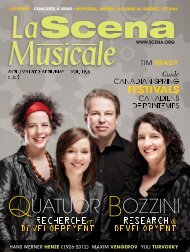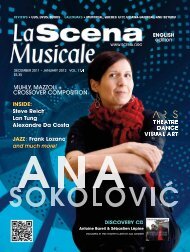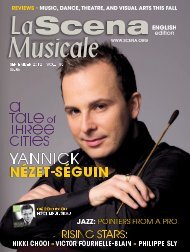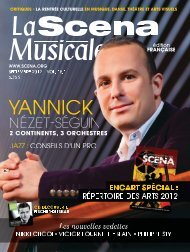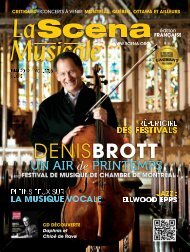Adobe Acrobat PDF complet (6 Meg) - La Scena Musicale
Adobe Acrobat PDF complet (6 Meg) - La Scena Musicale
Adobe Acrobat PDF complet (6 Meg) - La Scena Musicale
You also want an ePaper? Increase the reach of your titles
YUMPU automatically turns print PDFs into web optimized ePapers that Google loves.
ON BRUCKNER<br />
TWO CANADIAN GREATS REFLECT ON THE AUSTRIAN MASTERQ&A<br />
Paul E. Robinson<br />
YANNICK<br />
NÉZET-SÉGUIN<br />
WHAT ATTRACTED YOU TO BRUCKNER’S MUSIC?<br />
When I first heard a recording of a Bruckner symphony<br />
(No. 4), I didn’t like it... I was 14 at the time.<br />
But soon after, I heard the Ninth Symphony in the<br />
Basilique Notre-Dame (the MSO conducted by<br />
Skrowacewski), and I felt an immediate attraction.<br />
The mystical aspect, the vast proportions<br />
and the spiritual power of Bruckner speak to me<br />
like nothing else in the repertoire.<br />
WHAT ARE THE GREATEST CHALLENGES FOR A<br />
CONDUCTOR IN THE MUSIC OF BRUCKNER?<br />
Obviously, the control of the greater structure. Every<br />
line has a deep, long, horizontal quality, which has<br />
to breathe in a very specific way, and yet it is filled<br />
with a number of accompaniment figures often<br />
based on very simple motives; these are extremely<br />
important to get into place to allow the wonderful<br />
melodies to develop. It is like building extraordinarily<br />
solid pillars, the foundations to a gigantic but<br />
mobile structure, like a beautiful Boeing!<br />
YOU ARE PARTWAY THROUGH A PROJECT TO<br />
CONDUCT AND RECORD ALL THE BRUCKNER<br />
SYMPHONIES IN MONTREAL.<br />
Since I first conducted a Bruckner symphony<br />
(with the Metropolitain<br />
in 2002), I have felt very<br />
close to this music; it<br />
fulfills me as a musician.<br />
It represents to me<br />
the very essence of a<br />
conception of orchestral<br />
playing: every musician<br />
(including the conductor!)<br />
needs to somehow<br />
forget about himself or herself to be part of this<br />
wonderful “whole”... Embarking on this journey<br />
with the Metropolitain is representative of the<br />
in-depth work we have been doing together for<br />
almost ten years now, and with each symphony<br />
we are growing together. We are so lucky to have,<br />
in ATMA, such a wonderful artistic partner:<br />
Johanne Goyette always thinks artistically. We<br />
can freely exchange our musical projects and<br />
dreams, and this is certainly a wonderful one!<br />
HOW WOULD YOU DESCRIBE BRUCKNER’S<br />
SYMPHONIES?<br />
One major influence is Schubert, especially his last<br />
symphony, with its dimensions, its motivic writing,<br />
its harmony and its bucolic aspect, also very important<br />
in Bruckner’s work. Bruckner’s having been an<br />
organist is fundamental to his writing, with resonance<br />
and acoustical effects always so present.<br />
Like any other great composer, Bruckner was a<br />
visionary, but he was deeply rooted in a tradition,<br />
specifically choral music and organ literature. This<br />
last element is connected to the strong spirituality<br />
of his music, and that creates a very unique blend.<br />
THE FIRST AND THIRD MOVEMENTS OF THE<br />
EIGHTH ARE MARKED ALLEGRO MODERATO, AND<br />
YET IN RECORDINGS CONDUCTORS HAVE TAKEN<br />
VERY DIFFERENT TEMPI FOR THESE MOVEMENTS.<br />
Tempo is something one has to FEEL. If the phrasing<br />
is right, the pulse natural and the balance between<br />
the themes and sections logical, the “Tempo giusto”<br />
will appear. This is a long maturing process,<br />
needing countless hours of studying, meditating,<br />
feeling. And yet, the result may vary because of<br />
many factors: the orchestra, the hall, a different<br />
state of mind... In the case of a Bruckner symphony,<br />
because of the vast proportions, and the relatively<br />
few tempo indications, it is even more difficult to<br />
find an answer to all these questions. But it is also<br />
why I am so attracted to this music, and why it<br />
gives me such a profound experience to share that<br />
love with the musicians and the audience. ■<br />
Yannick Nézet-Séguin conducts Bruckner<br />
> June 15 @ 7:30 p.m.; Place des Arts, Salle Wilfrid-<br />
Pelletier; 514-842-2112, 866-842-2112<br />
> June 17 @ 7:30 p.m.; Église Notre-Dame-des-Sept-<br />
Douleurs; 4155, rue Wellington, > Montréal; 514-765-7150<br />
> June 18 @ 8 p.m.; Cégep Marie-Victorin, Salle Désilets;<br />
7000, rue Marie-Victorin, Montréal; 514-872-9814<br />
> June 22 @ 8 p.m.; Église Saint-Nom-de-Jésus;<br />
4215, rue Adam, Montréal; 514-872-2200<br />
www.orchestremetropolitain.com<br />
RAFFI<br />
ARMENIAN<br />
WHAT WERE SOME OF THE HIGHLIGHTS OF<br />
YOUR STUDIES IN VIENNA?<br />
I studied voice with my wife Agnes Grossman’s<br />
father Ferdinand, who sang as a child in a chorus<br />
conducted by Bruckner. He told us about how<br />
Bruckner rehearsed. First, he got on his knees<br />
next to the organ and prayed. Then he conducted<br />
the entire rehearsal with his coat on even though<br />
it was summer. At the end he put his hands in his<br />
pockets and brought out sweets and gave them<br />
all to the boys. It is also important to know<br />
Austrian folk music to understand his music,<br />
especially his scherzos. For example, in the scherzo<br />
of the Seventh Symphony the first two beats<br />
must be close together just as they are in the<br />
ländler and in the Viennese waltz. You can’t simply<br />
play the music as written.<br />
YOUR CONDUCTING TEACHER WAS HANS<br />
SWAROWSKY, WHO ALSO TAUGHT CLAUDIO<br />
ABBADO AND ZUBIN MEHTA. WHAT WAS HE LIKE?<br />
He taught me how to interpret the Austro-<br />
Hungarian style. I have chosen this very difficult<br />
symphony for the music camp and the tour, to<br />
give our students this understanding.<br />
WHAT WAS YOUR IMPRESSION IN YOUR EARLY<br />
DAYS AS A CONDUCTOR IN CANADA?<br />
When I first conducted in Canada, I had the impression<br />
people didn’t understand Bruckner’s symphonies<br />
and found them very long. People responded<br />
to the sound of a Mahler symphony but didn’t<br />
understand the music’s tradition. In Bruckner the<br />
sound is not so varied. But in his orchestra he tried<br />
to capture the sound of the organ, the connection<br />
with the Catholic world that meant so much to<br />
him. Again, that picture of Bruckner praying before<br />
he conducted a rehearsal is a picture that haunts<br />
me even though I wasn’t there to see it.<br />
IN THE SEVENTH SYMPHONY—SPECIFICALLY, THE<br />
SECOND MOVEMENT ADAGIO—FOR THE FIRST<br />
TIME, BRUCKNER ADDED THE WAGNER TUBAS<br />
TO HIS ORCHESTRATION. WHY?<br />
Wagner first used these instruments in the Ring<br />
and their use in Bruckner’s Seventh symphony is a<br />
kind of tribute to Wagner. Bruckner wanted the<br />
unique sound of these instruments in his music.<br />
Our students will use Wagner tubas in our performances<br />
of the Seventh. I have also asked our students<br />
to use rotary-valve trumpets, which are used<br />
in Vienna and have a warmer sound than the trumpets<br />
used in North American orchestras, and they<br />
blend with the other brass instruments better. The<br />
Viennese Romantics used the trumpet as a more<br />
lyrical instrument than composers elsewhere.<br />
WHICH EDITION DO YOU USE?<br />
Swarowsky discussed the problems of the various<br />
editions thoroughly in his conducting classes.<br />
Basically, I am using the Novak edition because it<br />
is the most recent and its score is closest to the<br />
manuscript.<br />
THE CYMBAL CRASH WAS APPARENTLY NOT IN<br />
THE ORIGINAL MANUSCRIPT BUT WAS INSERTED<br />
BY BRUCKNER ON A SEPARATE PAGE ON A SUG-<br />
GESTION BY THE CONDUCTOR ARTHUR NIKISCH.<br />
I think it is justified. It is a big question mark.<br />
Perhaps it is a Wagnerian gesture. Perhaps it is<br />
Bruckner’s salute to theatre—Wagner’s kind of<br />
musical theatre. Bruckner was such a humble man.<br />
We don’t know where the influences stopped and<br />
the ego began. Don’t forget that this was a time<br />
when people, including Mahler, didn’t hesitate to<br />
change the music they conducted. But we have a<br />
different attitude today. We are more conscious of<br />
musicological correctness. Nonetheless, we must<br />
go beyond our research to make the music live. ■<br />
Raffi Armenian conducts Bruckner’s Seventh<br />
Symphony as part of a special presentation by the<br />
Conservatoire de musique et d’art dramatique du<br />
Québec. Ninety of the best students from the various<br />
branches of the Conservatoire will form a festival<br />
orchestra. Québec City (June 5), Montréal (June 6),<br />
and Trois Rivières (June 7). conservatoire.gouv.qc.ca<br />
Juin 2009 June 13



